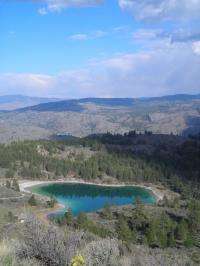Multiple proxy datasets can clarify ancient climate regimes

(Phys.org) -- Tree ring and oxygen isotope data from the U.S. Pacific Northwest do not provide the same information on past precipitation, but rather than causing a problem, the differing results are a good thing, according to a team of geologists.
The researchers are trying to understand the larger spatial patterns and timing of drought in the arid and semiarid areas of the American West.
"We generally understand that the Medieval Climate Anomaly, a warm period in much of the northern hemisphere that occurred about 950 to 1250 was a dry period in the American West," said Byron A. Steinman, postdoctoral researcher in meteorology, Penn State. "But there is complexity to the patterns of drought and it may not have been dry in winter in the Pacific Northwest."
East of the Cascade Mountains, the Pacific Northwest is dry and hot in the summer and wet in the winter now.
Estimates of past precipitation are made from proxies like tree rings, which can record amounts of precipitation and temperature. But tree rings are better at recording what happens during the spring and summer, when the tree is growing, than in the winter when the tree is not.
Steinman, who worked with Mark B. Abbott, professor of geology and planetary science, University of Pittsburgh, his Ph.D. advisor, looked at oxygen isotopes found in 1,500 years of sediment at the bottom of lakes. The isotopic composition of these sediments can reflect the amount of water that enters the lake, especially during the wet season.
The analyzed lake sediments contain calcium carbonate in the form of calcite. The oxygen isotope ratios in this mineral relate directly to the isotope ratio of water in the lake. The researchers looked at sediment from two small lakes in Washington state. Castor Lake is on a plateau and water inflow is only from precipitation and groundwater. This lake has no outflow, so most water loss is through evaporation. Lime Lake, on the other hand, loses the majority of water through a permanent outflow stream, although all water enters in the same manner as for Castor Lake. By comparing the two lakes, the researchers could determine the water balance between evaporation and precipitation.
The researchers looked at two stable isotopes of oxygen -- oxygen 16 and oxygen 18 -- in the sediments. Oxygen 16 is lighter than oxygen 18, so during evaporation and lake draw down, more oxygen 16 evaporates out and the calcite in the sediments contain more oxygen 18. If the lakes are full of water, then there will be more oxygen 16 in the calcite. The layers of sediment that are laid down each year can be dated either by using carbon 14 dating of organic material or by locating layers of tephra -- volcanic ash, that signifies known -- dated volcanic eruptions. In this way, the researchers could pinpoint when drought occurred.
"The tree ring data and isotope data match up on a short term, decadal scale," said Steinman. "On a longer term, century scale, the records diverge."
While the decadal ups and down remain the same for both proxies, when viewed on a 100-year or longer scale, the proxies show differences. The tree ring data suggest dry conditions during the Medieval Climate Anomaly summers, while the isotope data suggests wetter than expected winters.
Comparing the lake sediment records to existing records of the Pacific Decadal Oscillation, a warming or cooling of the coastal waters off the Pacific Northwest, the researchers report in the current online issue of the Proceedings of the National Academy of Sciences "a strong centennial timescale relationship over the past 1,500 years between winter precipitation amounts in eastern Washington and Pacific Decadal Oscillation temperature anomalies."
The PDO is linked to the El Nino Southern Oscillation, a tropical phenomenon that influences global weather patterns. During and before the Medieval Climate Anomaly, the North Pacific Ocean was warmer and Washington had greater precipitation than during the Little Ice Age, which occurred from about 1450 to 1850, when there was less precipitation.
Steinman used a previously published and validated model based on established lake physics and modern recorded precipitation and temperature to determine the amounts of rainfall indicated by the isotopic record
"The best thing we could do now is to produce additional quantitative precipitation records, this time with different lake systems," said Steinman.
More information: “1500 year quantitative reconstruction of winter precipitation in the Pacific Northwest,” by Byron A. Steinman, Mark B. Abbott, Michael E. Mann, Nathan D. Stansell, and Bruce P. Finney, PNAS, 2012.
Provided by Pennsylvania State University
















